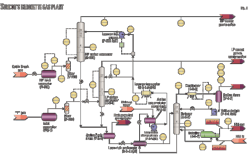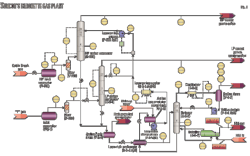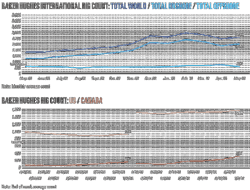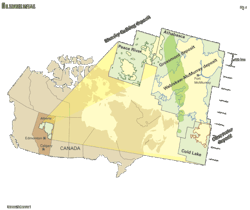Work flow reveals fault complexity
An effective quality control work flow using basic fault scaling relationships and distributions can help interrogate mapped prospects or appraised fields.
Using displacement-length and cumulative frequency plots, in conjunction with fault seal information, it is possible to rapidly determine if an appropriate level and amount of plausible faults have been mapped in an area of interest. Plotting fault attributes for a field may reveal anonymous curves or gaps that can signify missing faults, noncritical fault mapping, inappropriate fault linking, or interpreters mapping at different scales.
The advantages of this work flow are that it will reduce the time required to effectively map the structural complexity needed to appraise a target, provide an estimate of total number of mappable faults, assess the quality of currently mapped faults, and approximate the number of unmapped faults in areas of poor data.
Scaling and frequency
Faults that form via similar processes often appear very similar over several orders of magnitude (Fig. 1).
Fault-size distribution and scaling relationships, therefore, have been thoroughly documented over many orders of magnitude1 in different rheologies2 and faults types,3 but no definitive correlations have been established. Recent studies have accounted for scaling relationship discrepancies and noted mechanical stratigraphy, seismic resolution, fault linkage, and fault reactivation as sources of potential error.3-5
The general fault scaling relationship is D = cLn, where D is maximum displacement, c is a constant that is related to rock strength, L is length, and n is a scaling factor.
Most studies have concluded n is between 0.5 and 2. The exact value is not considered significant to the work flow proposed because the resolution and uncertainty involved with mapping faults in seismic data will produce a certain amount of data scattering. As long as the fault data plot is within general scaling relationships (Fig. 2) the fault is considered possible, but not necessarily correctly mapped.
Cumulative frequency plots of fault data have also previously been shown to correlate well over several orders of magnitude and provided a good approximation of potential fault complexity.6-9 These plots allow for visual display of anomalous faults or distributions.
Interpreting these plots, along with fault length-displacement plots, has significant quality control potential even if there are not enough faults mapped to derive reliable missing fault complexity or estimates.
Work-flow methodology
Faults and key horizons in a given seismic volume or dataset must first be mapped as accurately as possible, and particular attention must be paid to how faults linked. If faults are hard-linked then it may be appropriate to signify those planes as one fault even though it would be more geologically accurate to have two faults represented.3-5
Fault linkage has important implications on fault seal and seal capacity studies, and from these studies the minimum throw of a fault with sealing potential can be estimated and noted. The seismic volume or datasets resolution should be also represented on the fault attribute plots in order to convey quality data and the amount of complexity captured in an interpretation.
Ideally, the majority of mapped faults would not be laterally restricted,5 whereas their length-displacement relationship would be skewed. Other fault displacement assumptions must also be made in order to derive fault length-displacement relationships.
Since fault throw is easier to quantity than fault length, and maximum displacement rarely is captured in a given horizon map, the maximum throw at a particular horizon will be used in this work flow.
Given fault length is less constrainable due to the inability to accurately map fault tips,9 there will be a tendency for the data to have some spread. Therefore, fault length-displacements plots should use scaling brackets to show the likely limits of plausible faults.
This article will use a general fault scaling relationship of D = Lx, where x is between 10 and 100. Faults that lie outside this range on a log/log plot of maximum throw versus length should be further scrutinized. Further analysis of fault distributions can then be undertaken after anomalous faults are examined and remapped if needed.
Cumulative frequency plots are created by first calculating the number of faults that fall within specific, user-defined intervals and then adding the cumulative number of faults greater than or equal to the lower number in the interval. For example, if one fault has a displacement within the largest interval and eight faults fall within the next largest interval, the cumulative frequency would be one and nine, respectively.
After both plots (cumulative frequency and displacement length) are generated for a mapped interval or horizon, it is highly beneficial to attempt to perform quality control on either particular faults or distributions until both plots qualitatively look acceptable. This iterative process can take significant time if the initial interpretations are poor or if multiple interpreters have mapped portions of the dataset.
Some interpreters tend to link overlapping faults ("clumpers") and others prefer to map discrete fault segments ("splitters"). If this is the case, fault throw-length plots may appear good, but the cumulative frequency plot would show two distinctive high sections.
Fault attribute plots
With high resolution data and a considerable amount of time, it is possible to map every resolvable fault in the dataset and produce a highly accurate map and fault framework. The utility of such an endeavor, however, would be highly questionable.
At a certain stage during the mapping process there comes a point of diminishing returns. If the interpreter has adequately captured the complexity needed to assess a prospect, which is commonly when all faults with sealing potential are mapped, then the mapping of smaller faults can be concluded.
Flow baffles or smaller faults are important to model and capture but are not critical at this stage of exploration. To make reservoir modeling programs work faster, small faults are commonly removed and transmissibility factors are incorporated into the geocellular grids to capture these heterogeneities.
All the mappable faults with sealing potential are commonly not captured because it is difficult to decide how small of a fault is significant (Fig. 3). If the cumulative frequency line starts to flatten out before crossing the estimated throw of faults with sealing potential, then mapping should be continued.
Using attribute plots iteratively while mapping will help address this issue and also designate anomalous faults that ought to be revisited and potentially revised (Figs. 4 and 5).
Another utility of characterizing the potential amount of complexity missing in a given interpretation is the areal density of significant faults can be interpolated9 across areas of poorer data quality (Fig. 6). Using a moving window, it is possible to estimate the number of faults that intersect that window.
The number of faults is then assigned to corresponding node in the middle of the moving window. The nodes in the area with poorer data can then be omitted and an interpolated grid can estimate the number of faults that may be present in this area as long as there are no gridding problems or artifacts (i.e., the node spacing is too spaced or the poor data area is on a grid edge).
Further estimates can be made from a fault density map if the cumulative frequency plot denotes a certain number of faults are missing from an interpretation. The number of missing faults can be applied or added to the density map to help assign the risk associated with prospecting in a particular region.9 Under ideal circumstances, a fault density map should be completed after the fault framework is finalized to an appropriate level.
This article presents a quality control work flow that incorporates well-established fault attribute correlations (fault length displacement and cumulative frequency plots) to interrogate mapped prospects. Using this work flow it is possible to:
• Assess a fault interpretation.
• Determine the level of mapping currently captured.
• Determine if more detailed mapping is needed.
• Estimate fault density in areas of poor data.
• Determine how much fault complexity may be missing.
Acknowledgments
Thanks to BP for the opportunity to publish this work, and thanks to Pablo Cervantes and Jaime Martinez for discussions regarding mapping work flows and effective modeling practices. ✦
References
1. Schlische, R.W., Young, S.S., Ackermann, R.V., and Gupta, A., "Geometry and scaling relations of a population of very small rift-related normal faults," Geology, Vol. 24, 1996, pp. 683-686.
2. Hatcher, R.D. Jr., "Properties of thrusts and upper bounds for the size of thrust sheets," in McClay, K.R., ed., "Thrust tectonics and hydrocarbon systems," AAPG Memoir 82, 2004, pp. 18-29.
3. Kim, Y., and Sanderson, D.J., "The relationship between displacement and length of faults: A review," Earth-Science Reviews, Vol. 68, 2005, pp. 317-334.
4. Dawers, N.H., and Anders, M.H., "Displacement-length scaling and fault linkage," Journal of Structural Geology, Vol. 17, 1995, pp. 607-614.
5. Nicol, A., Watterson, J., Walsh, J.J., and Childs, C., "The shapes, major axis orientations and displacement patterns of fault surfaces," Journal of Structural Geology, Vol. 18, 1996, pp. 235-248.
6. Nicol, A., Walsh, J.J., Watterson, J., and Gillespie, P.A., "Fault size distributions—are they really power law?," Journal of Structural Geology, Vol. 18, 1996, pp. 191-197.
7. Peacock, D.C.P., and Parfitt, E.A., "Active relay ramps and normal fault propagation on Kilauea Volcano, Hawaii," Journal of Structural Geology, Vol. 24, 2002, pp. 729-742.
8. Pickering, G., Bull, J.M., and Sanderson, D.J., "Sampling power-law distributions," Tectonophysics, Vol. 248, 1995, pp. 1-20.
9. Yielding, G., Walsh, J., and Watterson, J., "The prediction of small-scale faulting in reservoirs," First Break, Vol. 10, 1992, pp. 449-460.
The author
More Oil & Gas Journal Current Issue Articles
More Oil & Gas Journal Archives Issue Articles




